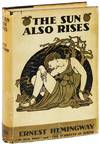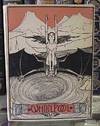
Harmonics, or the Philosophy of Musical Sounds.
by SMITH, Robert
- Used
- first
- Condition
- See description
- Seller
-
London, United Kingdom
Payment Methods Accepted
About This Item
Cambridge: printed by J. Bentham and sold there by W. Thurlbourn and T. Merrill, and by S. Austen and J. Whiston in London,, 1749. Large-paper, presentation, Macclesfield copy First edition, large paper copy, presentation copy to the author's fellow mathematician William Jones, inscribed on the front free endpaper verso, "From the Author to Wm Jones Esq", afterwards in the celebrated Macclesfield library and in the typically fresh condition of that library. Altogether, an exceptionally desirable copy. The Welsh mathematician William Jones (1675-1749) is remembered for introducing the mathematical symbol for pi. He was a close friend of Newton and Halley, and a fellow and vice-president of the Royal Society. His library of some 15,000 books was considered "the most valuable mathematical library in England" (ODNB), and was bequeathed to George Parker, second Earl of Macclesfield (c.1695-1764), where it joined an already extraordinary collection. The Macclesfield library ranked as one of the finest country house libraries in Britain, with both the first and second Earls of Macclesfield acquiring books on a vast range of subjects. The books were still in a remarkably fresh state of preservation when the library was eventually dispersed in the early years of the 21st century in a series of celebrated sales at Sotheby's; this copy lot 1499, and distinguished by the Macclesfield bookplate to the front pastedown (South Library, press mark 184 D. 14) and their blindstamp to the initial leaves. Robert Smith (1689-1768) was, like Jones, a leading Newtonian, and his 1738 work A Compleat System of Opticks was the standard account of Newtonian optics for the rest of the century. His other great interest was music, and Harmonics was his major work in the field, "highly regarded by many later eminent scientists... He was an accomplished performer on several instruments, particularly the violoncello, and possessed a 'correct ear'. In his Harmonics he advocated the mean-tone temperament or method of tuning keyboard instruments. In the same work he contributed to the mathematical theory of music with an extended discussion of equal harmonic intervals. He directed the construction of the organ at the Foundling Hospital, which incorporated his system of alternative notes. Although his system found a champion in A. D. McClure in the 1940s, it has rarely been employed in keyboard instruments because of its complexity and the expense involved in constructing the instruments" (ODNB). Other presentation large-paper copies include that to George III, now in the British Library (BL 52e27). The king's copy was bound by the same binder as this copy, with the same spine tools and title label, though in red morocco with his royal supralibros and further gilt embellishments. Large octavo (225 x 142 mm). Contemporary calf, orange morocco label, spine gilt in compartments, double gilt rule frame to covers with floral cornerpieces, marbled endpapers, red edges. With 25 folding plates, and 3 folding tables. Slight rubbing at extremities, very light insect damage at foot of front joint and wear at foot of spine, bump to rear cover upper out corner, the binding still firm and handsome, contents clean and fresh, all folding plates without tears. An excellent copy. ESTC N7143.
Reviews
(Log in or Create an Account first!)
Details
- Bookseller
- Peter Harrington
(GB)
- Bookseller's Inventory #
- 154664
- Title
- Harmonics, or the Philosophy of Musical Sounds.
- Author
- SMITH, Robert
- Book Condition
- Used
- Place of Publication
- Cambridge: printed by J. Bentham and sold there by W. Thurlbourn and T. Merrill, and by S. Austen and J. Whiston in London,
- Date Published
- 1749
Terms of Sale
Peter Harrington
All major credit cards are accepted. Both UK pounds and US dollars (exchange rate to be agreed) accepted. Books may be returned within 14 days of receipt for any reason, please notify first of returned goods.
About the Seller
Peter Harrington
Biblio member since 2006
London
About Peter Harrington
Since its establishment, Peter Harrington has specialised in sourcing, selling and buying the finest quality original first editions, signed, rare and antiquarian books, fine bindings and library sets. Peter Harrington first began selling rare books from the Chelsea Antiques Market on London's King's Road. For the past twenty years the business has been run by Pom Harrington, Peter's son.
Glossary
Some terminology that may be used in this description includes:
- Morocco
- Morocco is a style of leather book binding that is usually made with goatskin, as it is durable and easy to dye. (see also...
- Inscribed
- When a book is described as being inscribed, it indicates that a short note written by the author or a previous owner has been...
- Spine
- The outer portion of a book which covers the actual binding. The spine usually faces outward when a book is placed on a shelf....
- Bookplate
- Highly sought after by some collectors, a book plate is an inscribed or decorative device that identifies the owner, or former...
- Octavo
- Another of the terms referring to page or book size, octavo refers to a standard printer's sheet folded four times, producing...
- Blindstamp
- A blindstamp is a stamped impression, usually an image, logo, words, or design on the cover or spine of a book, without color or...
- First Edition
- In book collecting, the first edition is the earliest published form of a book. A book may have more than one first edition in...
- Calf
- Calf or calf hide is a common form of leather binding. Calf binding is naturally a light brown but there are ways to treat the...
- Edges
- The collective of the top, fore and bottom edges of the text block of the book, being that part of the edges of the pages of a...
- Rubbing
- Abrasion or wear to the surface. Usually used in reference to a book's boards or dust-jacket.
- Gilt
- The decorative application of gold or gold coloring to a portion of a book on the spine, edges of the text block, or an inlay in...
- Leaves
- Very generally, "leaves" refers to the pages of a book, as in the common phrase, "loose-leaf pages." A leaf is a single sheet...
- Verso
- The page bound on the left side of a book, opposite to the recto page.





